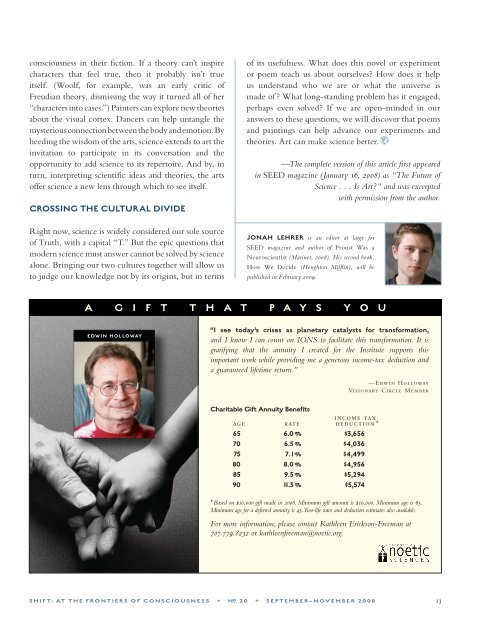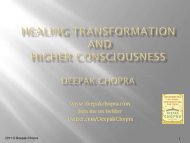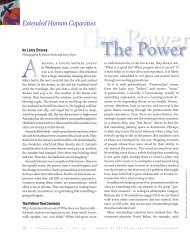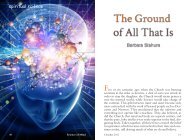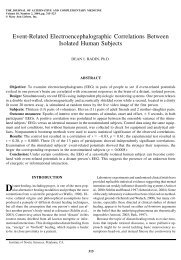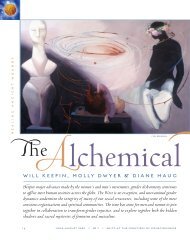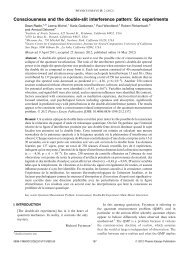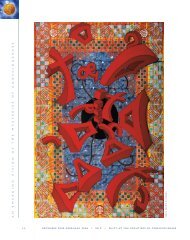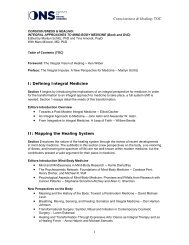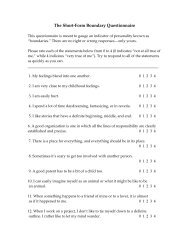Why Science Needs Art - Institute of Noetic Sciences
Why Science Needs Art - Institute of Noetic Sciences
Why Science Needs Art - Institute of Noetic Sciences
You also want an ePaper? Increase the reach of your titles
YUMPU automatically turns print PDFs into web optimized ePapers that Google loves.
consciousness in their fiction. If a theory can’t inspire<br />
characters that feel true, then it probably isn’t true<br />
itself. (Woolf, for example, was an early critic <strong>of</strong><br />
Freudian theory, dismissing the way it turned all <strong>of</strong> her<br />
“characters into cases.”) Painters can explore new theories<br />
about the visual cortex. Dancers can help untangle the<br />
mysterious connection between the body and emotion. By<br />
heeding the wisdom <strong>of</strong> the arts, science extends to art the<br />
invitation to participate in its conversation and the<br />
opportunity to add science to its repertoire. And by, in<br />
turn, interpreting scientific ideas and theories, the arts<br />
<strong>of</strong>fer science a new lens through which to see itself.<br />
CROSSING THE CUlTURAl DIVIDE<br />
Right now, science is widely considered our sole source<br />
<strong>of</strong> Truth, with a capital “T.” But the epic questions that<br />
modern science must answer cannot be solved by science<br />
alone. Bringing our two cultures together will allow us<br />
to judge our knowledge not by its origins, but in terms<br />
<strong>of</strong> its usefulness. What does this novel or experiment<br />
or poem teach us about ourselves? How does it help<br />
us understand who we are or what the universe is<br />
made <strong>of</strong> ? What long-standing problem has it engaged,<br />
perhaps even solved? If we are open-minded in our<br />
answers to these questions, we will discover that poems<br />
and paintings can help advance our experiments and<br />
theories. <strong>Art</strong> can make science better.<br />
—The complete version <strong>of</strong> this article first appeared<br />
in SEED magazine (January 16, 2008) as “The Future <strong>of</strong><br />
<strong>Science</strong> . . . Is <strong>Art</strong>?” and was excerpted<br />
with permission from the author.<br />
JONAH lEHRER is an editor at large for<br />
SEED magazine and author <strong>of</strong> Proust Was a<br />
Neuroscientist (Mariner, 2008). His second book,<br />
How We Decide (Houghton Mifflin), will be<br />
published in February 2009.<br />
A G I F T T H A T P A Y S Y O U<br />
EDWIN HOLLOWAY<br />
“I see today’s crises as planetary catalysts for transformation,<br />
and I know I can count on IONS to facilitate this transformation. It is<br />
gratifying that the annuity I created for the <strong>Institute</strong> supports this<br />
important work while providing me a generous income-tax deduction and<br />
a guaranteed lifetime return.”<br />
Charitable Gift Annuity Benefits<br />
income tax<br />
age rate deduction *<br />
65 6.0% $3,656.<br />
70 6.5% $4,036.<br />
75 7.1% $4,499.<br />
80 8.0% $4,956.<br />
85 9.5% $5,294.<br />
90 11.3% $5,574.<br />
—Edwin Holloway<br />
Visionary Circle Member<br />
*Based on $10,000 gift made in 2008. Minimum gift amount is $10,000. Minimum age is 65.<br />
Minimum age for a deferred annuity is 45.Two-life rates and deduction estimates also available.<br />
For more information, please contact Kathleen Erickson-Freeman at<br />
707.779.8232 or kathleenfreeman@noetic.org.<br />
SHIFT: AT THE FRONTIERS OF CONSCIOUSNESS • # 20 • SEPTEMBER–NOVEMBER 2008 13


